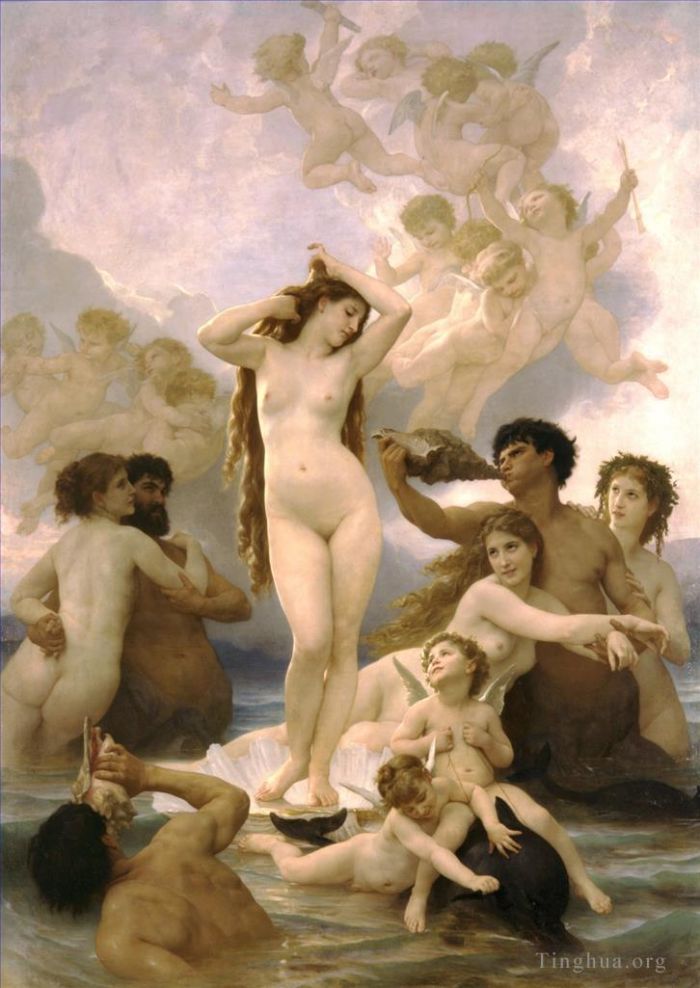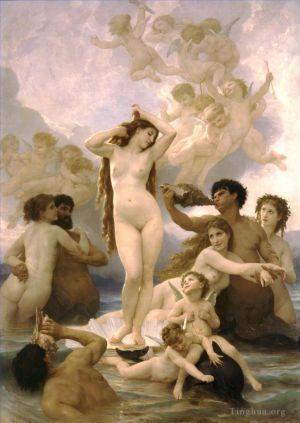The Birth of Venus
William-Adolphe Bouguereau
- Price: Price on Request
- Art Type: Oil Painting
- Size:
- English Comments: 0
- International Comments: 0
- Creating Date:
- Introduction and Works of William-Adolphe Bouguereau >>
Work Overview
- The Birth of Venus
French: La Naissance de Vénus
Artist William-Adolphe Bouguereau
Year 1879
Medium oil on canvas
Dimensions 300 cm × 218 cm (120 in × 86 in)
Location Musée d'Orsay
The Birth of Venus (French: La Naissance de Vénus) is one of the most famous paintings by 19th-century painter William-Adolphe Bouguereau. It depicts not the actual birth of Venus from the sea, but her transportation in a shell as a fully mature woman from the sea to Paphos in Cyprus. She is considered the epitome of the Classical Greek and Roman ideal of the female form and beauty, on par with Venus de Milo.
For Bouguereau, it is considered a tour de force. The canvas stands at just over 9 ft 10 in (3.00 m) high, and 7 ft 2 in (2.18 m) wide. The subject matter, as well as the composition, resembles a previous rendition of this subject, Sandro Botticelli's The Birth of Venus, as well as Raphael's The Triumph of Galatea.
The Birth of Venus was created for the Paris Salon of 1879. It was awarded the Grand Prix de Rome,[1] and was purchased by the state for the Musée du Luxembourg.[2] The painting is now in the permanent collection of the Musée d'Orsay in Paris.
At the center of the painting, Venus stands nude on a scallop shell[3] being pulled by a dolphin, one of her symbols. Fifteen putti, including Cupid and Psyche, and several nymphs and centaurs have gathered to witness Venus' arrival. Most of the figures are gazing at her, and two of the centaurs are blowing into conch and Triton shells, signaling her arrival.
Venus is considered to be the embodiment of feminine beauty and form, and these traits are shown in the painting.[3] Her head is tilted to one side, and her facial expression reflects that she is calm and comfortable with her nudity. She raises her arms,[4] arranging her thigh-length, brown hair, swaying elegantly in an "S" curve contrapposto, emphasizing the curves of her body.[5]
The model for Venus was Marie Georgine, princess of Ligne. In 1861, she was on a short holiday in Paris with her lover. Together, they modeled for Bouguereau's "Abduction of Psyche" and "Flora and Zephyr". He worked out Venus and other sketches and paintings later from photographs he took of the couple. Some of Bouguereau's other works, like La Nuit, are also based on her. Marie was also painted by Léon Bonnat and photographed by Antoine Samuel Adam-Salomon.
Venus' figure was enlarged from a nymph from Bouguereau's The Nymphaeum, completed in 1878, a year earlier.[5] The nymph is slightly thinner, and her breasts are fuller and more rounded. Venus' contrapposto is more intense, and her hair is also longer and lighter than the nymph's, but she arranges it almost identically.
To the upper-left of the painting, there is a shadow in the clouds. It appears to be the silhouette of the artist, with a head, shoulder, arm, and a raised fist that would seem to hold a paintbrush.
The most common form of historicism that reused styles of past ages, often in eclectic combinations, was the sensual, seductive, stylish portrayal of beautiful women, the supposed subject could be taken from Christianity, or from Greek or Roman myth. Bouguereau, an academy member since 1876, was one of the foremost artists of this kind. A devout Catholic, he was out to oppose traditional ethical values to the materialism of the world about him, but all he managed was the frisson of superficial delights. There was an unbridgeable gap between his art and that of Renoir, or indeed Cézanne.
- Copyright Statement:
All the reproduction of any forms about this work unauthorized by Singing Palette including images, texts and so on will be deemed to be violating the Copyright Laws.
To cite this webpage, please link back here.
- >> English Comments
- >> Chinese Comments
- >> French Comments
- >> German Comments
- >>Report
- Litalienne au tambourin
- Compassion
- Far Niente
- The Return of Spring
- The chilly
- Cupid and Psyche
- Jeune fille allant a la fontaine
- FemmeAuCoquillage 1885
- Jeune italienne puisant de leau
- The Madonna of the Lilies
- The Dance
- Le Baiser 1863
- The Shepherdess
- Reverie
- Girl with bouquet
- Homere et son guide
- The Prisoner
- After the Bath
- Le repos
- Tricoteuse 1879
- Charity
- Jeune ouvriere
- LAmour et Psyche enfants
- Parure des champs
- The Broken Pitcher
- Lady with Glove 1870
- Seated Nude
- Femme Blonde profil 1898
- La tricoteuse
- Adolphe Juene Fille Et Enfant MiCorps
- Portrait de lartiste
- Lidylle
- A Portrait of Leonie
- Idylle 1851
- Etude dune femme pour Offrande a lAmour
- Jeunes bohemiennes
- Le secret
- Le Jeune Bergere 1897
- Soul Carried to Heaven
- Sur la greve
- Temptation 1880
- Maternal Admiration
- The First Mourning
- Le jeune frere 1900
- Unfinished detail
- Sainte Famille
- NotreDame Des Anges
- The Nut Gatherers
- After the Bath
- Madame la Comtesse de Cambaceres
- Madone assise
- Evening Mood (Twilight or Dusk)
- Gabrielle Cot 1890
- Portrait of a Young Girl
- The Birth of Venus
- Cupid with Butterfly
- Work Interrupted
- Une Vocation
- Bohemienne au Tambour de Basque
- Jeune Fille et Enfant
- Etude tete de petite fille tete de petite fille
- Loin du pays
- La Vierge LEnfant Jesus et Saint Jean Baptiste2
- The Mischievous One
- Inspiration
- Le Lever
- Fileuse
- Faneuse
- Washerwomen of Fouesnant 1869
- Paquerettes
- Les Oreades 1902
- Psyche
- Young Woman Contemplating Two Embracing Children
- Boucles DOreilles The earrings 1891
- The Return from the Harvest
- Etude Femme Blondede face 1898
- Study for Vierge aux anges
- TheBather 1879
- Jeunesse Realism angel
- The Virgin with Angels (The Queen of the angels)
- La grappe de raisin
- Marguerite
- La brie du printemps
- La Soupe
- Berceuse
- Brother and Sister
- Au bord du ruisseau
- Psyche et LAmour
- The Nymphaeum
- Vierge consolatrice
- Baigneuse 1870
- Une vocation 1896
- The Youth of Bacchus
- Petite bergere
- A Portrait of Eugene
- Lart et la litterature
- Le Passage du gue
- Un moment repos
- The Heart’s Awakening
- La Charite 1859
- The Madonna of the Roses
- The Young Shepherdess
- Calinerie
- The Storm
- La bourrique oil on canvas
- Branche de laurier
- Le jour (Day)
- La reverence
- Mailice
- Lady Maxwell 1890
- Little beggars
- Avant le bain
- Jeune bergere 1868
- La vague
- Adolphe MAUVAISE ECOLIERE
- La priere
- Le gouter
- Pieta 1876
- Will8iam Dante et Virgile au Enfers
- The Goose Girl 1891
- Linnocence
- La Vierge LEnfant Jesus et Saint Jean Baptiste
- Beaute Romane 1904
- Loves Resistance 1885
- Moissoneuse
- The Motherland (Alma Parens)
- Reve de printemps
- A Portrait of Amelina Dufaud
- Unknown
- The Bohemian
- Portrait of a young girl 1896
- Irene
- Meditation
- The Assault
- Priestess
- La soeur ainee
- Day 1881
- The Shell
- La Vierge a Lagneau
- Bergere
- Orestes Pursued by the Furies
- Tobias Saying Goodbye to his Father 1860
- La lecon difficile
- Douleur damour
- Frere et Soeur
- Le jeune frere
- Bergere 1886
- Laurore
- Le retour du marche
- Petite boudeuse
- Song of the Angels (Virgin of the Angels)
- En penitence
- Le Crab
- La Petite Mendiante
- La soif
- The Shepherdess 1873
- The Invasion
- Petites maraudeuses
- Girl Holding Lemons 1899
- Zenobia Found by Shepherds
- Portrait Of Genevieve Celine Eldest Dau
- Flight of Love
- La Charite Romaine
- Portrait de Mlle Brissac
- Les pommes
- La palme
- Nymphs and Satyr
- Reflexion
- Flagellation of Our Lord Jesus Christ
- Wet Cupid
- The Abduction of Psyche
- The Bathers (The Two Bathers)
- Le jour des morts
- Ladmiration
- Les Jeunes Baigneuses
- Child Braiding A Crown
- Slumber
- The Little Marauder 1900
- The Pastoral Recreation 1868
- Mignon Pensive
- Unknown1
- The Knitting Girl
- Yvonne
- Meditation 1885
- Frere et soeur bretons
- Unfinished
- Biblis
- Portrait Of Madame Olry Roederer
- A Childhood Idyll
- La Gue
- Fardeau agreable
- La jeunesse de Bacchus centre dt
- The Thank Offering
- Jeune fille se defendant contre lamour
- Etude Tete de Jeune fille
- Retour des champs
- Lost Pleiad
- Les prunes
- Portrait de Mademoiselle Elizabeth Gardner
- Amour a laffut angel
- Harvester (The Grape Picker)
- La Comtesse de Montholon
- A la fontaine
- Portrait of a Young Girl Crocheting
- A Portrait of Genevieve
- La couturiere
- Femme de Cervara et Son Enfant 1861
- Modestie
- Deux soeurs
- Drawing of a Woman
- Night
- Mars
- Laurore Realism WilliamAdolphe
- Flagellation of Christ study in pencil
- Study of a Seated Veiled Female Figure









 Singing Palette
Singing Palette